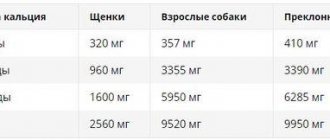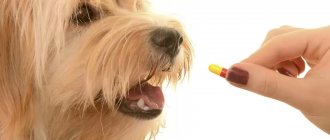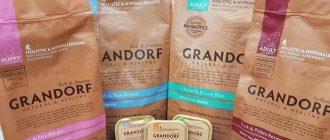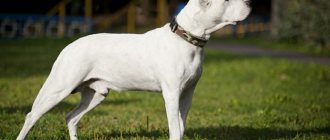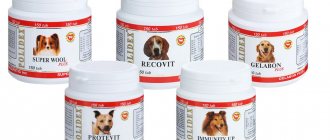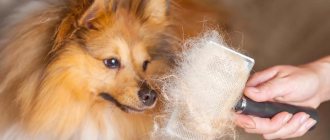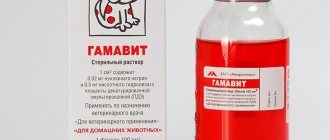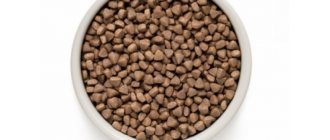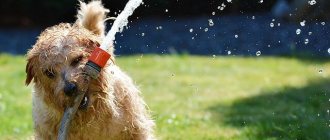Every dog owner believes that his pet is the most beautiful. But sometimes problems arise with the pet’s main decoration – the fur coat: the fur becomes dull, crumbles, and becomes dry to the touch. At the same time, the skin also suffers: it peels, turns red, and becomes covered with ulcers.
Vitamins for dogs for coat and skin will help restore health and beauty. I selected the 12 best complexes , considered their pros and cons, application nuances, and indicated prices.
Remember that expensive drugs are not always the best: therefore, in the review you will find cheap but excellent products and you will be able to choose the best one for your dog at the lowest price. Pay attention to the section at the end of the rating: it contains complexes for solving specific problems with fur coat and skin.
Hair loss: normal or pathological
Many dog breeds experience a seasonal coat change, which is normal. It should not cause concern for the health of the pet, as this is a natural process. Molting occurs twice a year. There is also “baby shedding,” which occurs in puppies between the ages of 3 and 9 months. During this period, delicate fluff falls out, and in its place, tougher, adult hair grows.
But if hair loss drags on and occurs too intensely, then this is a reason to consult a veterinarian. Coat problems can occur for a number of reasons. These include:
- unbalanced diet (deficiency of vitamins and minerals);
- improper grooming;
- infection with a fungal or parasitic disease;
- helminthiases;
- allergic reactions;
- stress (for example, when another pet appears in the house);
- taking hormonal medications;
- acute and chronic diseases, including hereditary ones;
One of the signs of serious diseases is focal hair loss while it persists in other areas.
To help your pet you need to find out the cause of the problem and begin to fight it.
Basic procedures
Combing
Regularity: once a week - for a short-haired dog, twice a week - if the Spitz is uncut. Rain while walking is a reason for extra brushing.
Means: combs with teeth of different frequencies, massage brushes - do not damage the hair and do not cause pain to the dog; conditioner and spray - make combing easier and improve appearance. Select the frequency of the teeth so that it does not allow tangles to pass through, but also does not pull out hairs. Do not use powder brushes: they injure the skin and cause inflammation.
Procedure: carried out at home, on a table, the dog should lie on its side; For the first time, you can brush the puppy on your lap. Mats often form in the groin, under the jaw, near the front legs and behind the ears. Pay attention to these places first. You need to brush in the direction from the tail to the head, against the growth of the hair - this way the skin is better aerated (especially important for wet wool). At the end, fluff the fur with your fingers - this way it will remain fluffy and stuffed longer. If your dog has problem hair, you have neglected it, cut the mats yourself. If you will be participating in an exhibition in the near future, it is better to contact a professional groomer: perhaps he will be able to untangle the tangles with the help of anti-tangle products.
If you have aggression when scratching, watch this video.
Bathing
Regularity: once every 1-2 months and outside the schedule before the exhibition.
Products: Use dog cosmetics for washing. Human (even expensive and well-known) shampoos are not suitable for this purpose.
How to choose dog cosmetics:
Procedure: carefully plug the dog's ears with cotton swabs to prevent water from getting into them, dilute the shampoo and conditioner separately with water, wet the skin well with warm water, distribute the shampoo, lather, rinse. Treat the washed fur with conditioner and rinse. Wash your Pomeranian only after brushing.
Drying
Remedies: do not just leave your dog to dry, be sure to use a hairdryer, which you will have to gradually accustom the animal to.
Procedure: First thoroughly dry (but do not rub!) the dog with a large towel, then dry with a hairdryer, lifting the hairs with a comb and directing warm air to their base. Dry wool needs moisturizing: apply a moisturizer to the under-dried coat and let it dry.
A haircut
Regularity: haircut is necessary occasionally: as needed to remove tangles, and before the exhibition. In any other case, it is not necessary to trim the Pomeranian's coat.
Procedure: the fur is trimmed, overgrown (usually by 1.5-2 years) pieces on the sides are removed, the ears are shaped, outside and inside. Trimmed fur looks more well-groomed.
You can cut your hair for the first time when your Pomeranian is 3 months old. Most often, Pomeranian owners choose the Mouton haircut. Never shave your Pomeranian head!
Other coat problems
Active hair loss in dogs is not the only problem that owners face. Shedding may occur within normal limits, but the fur itself looks dry, dull, and disheveled, which also requires consultation with a specialist and taking appropriate measures. Under no circumstances should symptoms such as itching, dry skin, and flaking be ignored.
Signs of a lack of nutrients
- Dryness and inelasticity of the skin.
- The coat is dry, disheveled, dull (except during the molting period).
- The presence of frequent local inflammatory foci on the skin, dermatitis (inflammation of the deep layers of the skin).
- Alopecia (baldness) complete or patchy.
- Persistent itching.
If you find one or more of these signs in your dog, then this is a reason to contact a veterinarian, because such symptoms are also suitable for some other diseases. Professional diagnosis is required.
What vitamins are important for a dog's health?
For normal growth and full development of a dog, vitamins must be supplied to its body along with food. Many of them, in addition to the general effect on organs and systems, have an additional effect on the animal’s fur.
Vitamin A.
Retinol is involved in the synthesis of collagen fibers, keratin and elastane. With a lack of this vitamin, the elasticity and silkiness of the coat is lost, and fragility is observed.
B vitamins.
These vitamins normalize the functioning of the sebaceous glands and are important in the fight against flaking of the skin. They are necessary to nourish the bulbs so that the coat is elastic. With a sufficient amount of B vitamins, hair loss is reduced, the undercoat grows, and hair fragility is eliminated.
Vitamin C.
Vitamin for maintaining the body's protective functions, helps resist infectious diseases and related complications.
Vitamin D
Indispensable for proper absorption of calcium and phosphorus. If it is deficient, your pet may experience problems with the musculoskeletal system.
Vitamin E.
Responsible for the normal functioning of the reproductive system, and it is also a powerful antioxidant.
Vitamins F and H.
Participate in the synthesis of keratin and are necessary for maintaining healthy skin, claws and coat.
Does a Spitz shed?
The Pomeranian is a highly shedding breed, mainly due to its very thick undercoat. It is not for those who are allergic to dogs. The first molt occurs at 3.5 - 4 months and then 2 times a year: in autumn and after winter. Bitches also change their coat before estrus and after giving birth. When your dog begins to shed, switch to daily grooming; the procedure is no different from regular combing, only it is performed even more carefully and longer in order to have time to remove all the dying hairs. If you don’t brush your shedding dog for at least one or two days, you risk getting a tightly matted “felt boot” of unshed hair that only needs to be cut.
Fatty acids and minerals
In addition to vitamins, the following minerals and fatty acids are also important for a dog's body.
Omega-3 and omega-6.
The importance of these substances for the body is difficult to overestimate. In addition, they give the coat a healthy shine and elasticity, can enhance pigmentation, and accelerate the restoration of the coat after illness.
Zinc.
This element supports normal thyroid function. Zinc is also associated with vitamin A: together they help reduce thinning guard hairs, hair loss and fragility.
Sulfur.
It is necessary to optimize the production of sebum by the skin glands. Sulfur is important for hair shaft proteins at the molecular level. Sulfur compounds form sulfide bridges.
Calcium and phosphorus.
Together with vitamin D, they support many processes in the body.
Manganese.
It is involved in the synthesis of keratin.
Copper.
With a deficiency of this substance, collagen formation is disrupted and healthy coat color is lost.
Selenium
. In its effect on the dog's body, selenium is similar to vitamin E. In addition, they work together. They have antioxidant properties, support the immune system, and help relieve stress.
Iron
. Lack of iron can cause anemia and other dangerous conditions.
Features of vitamin-mineral complexes
Natural food is good for your dog's health if it is properly balanced. However, doing this at home is quite difficult. You need to calculate the daily portion of meat (certain varieties), vegetables and other products. If a dog owner does not have the ability or knowledge to prepare a balanced diet, this may result in a lack of certain substances in the body. Modern high-quality feeds already contain the necessary components and their balance is maintained according to average statistical needs. But in some cases, to maintain the health of the dog, improve the coat and eliminate intense shedding, it is necessary to use special complexes with vitamins. Their selection is very large. They may differ in release form (tablets, capsules, drops, injection solutions), composition (combination of active substances) and dosage. Your doctor will help you choose certain vitamins for hair growth in dogs.
Owner reviews
Violetta: “I never wanted to cut my dog’s hair short, because, in my opinion, such hair is unpleasant to the touch. We once had our ponytail cut short, and at the slightest tactile contact it was noticeable that the smoothness that, say, was on the back had disappeared.”
Sasha: “The most amazing thing is that after combing a huge mountain of fur, my dog only becomes fluffier. And even easier. The groomer said that you shouldn't put a harness on a Pomeranian because it creates more tangles in the armpits. But I think it’s better to have tangles than to torment my baby with a collar or a noose.”
Vitamin preparations
Isidivit®.
Emulsion for injection, designed to increase the body's natural resistance, maintain immunity, normalize metabolism and other functions. Prescribed by a veterinarian for sick and weakened animals. Aisidivit® belongs to complex immunostimulating drugs. It contains ASD 2-F substance, vitamins A and E, and succinic acid.
"VitOkey."
A drug developed for the prevention and treatment of hypovitaminosis, as well as diseases that can develop against their background. It can be prescribed as part of complex therapy for stress, poisoning, invasive diseases and diseases of non-contagious etiology. The product is available for parenteral administration (by injection). "VitOkey" contains a complex of essential vitamins in a physiologically based ratio: A, D3, E, K, B1, B2, B6, nicotinamide, calcium pantothenate, cyanocobalamin, folic acid, biotin. The multicomponent composition makes the drug especially effective in cases of deficiency of several vitamins at once, which is often found in infectious and invasive diseases, massive blood loss and severe injuries.
"Vittri-1".
This is an oil solution of vitamins A, D3, E, which are in physiologically reasonable proportions. "Vittri-1" refers to combined vitamin preparations. It is suitable for the prevention and complex treatment of hypovitaminosis, xerophthalmia, rickets, osteomalacia, some dermatitis, poorly healing wounds and ulcers, inflammation of the mucous membranes in combination with the main therapy. The drug helps normalize metabolism. It is distinguished by convenient packaging, ease of use (for oral administration it is mixed with food) and storage. The drug is compatible with other medicines and feed.
"Vittri-3".
A combined vitamin preparation in the form of an oil solution of vitamins A, D3, E. According to recommendations for use and effect, it is similar to Vittri-1. The difference lies in the method of application. Vittri-3 is administered subcutaneously or intramuscularly. Prescribed to animals with reduced or absent appetite, with serious diseases and disorders, when the feed form is not effective enough.
"Bone."
This is a mineral and vitamin supplement for dogs, which contains vitamins, macro- and microelements, and biologically active substances. The basis of the product is high-quality bone meal. The supplement is made from environmentally friendly raw materials and does not contain preservatives or dyes. It is used to prevent mineral and vitamin deficiency and has a general beneficial effect on the animal’s body. The “Kostochka” series includes 6 products: with brewer’s yeast, with seaweed, with succinic acid, as well as “Kostochka vitamin”, “Kostochka immunovit” and “Kostochka multivitamin”. As vitamins for dog fur, we can separately recommend “Bone with Brewer’s Yeast.” It promotes wool growth and improves its structure. In addition, “Bone with seaweed” can be recommended. Its active substances promote hair growth and enhance the intensity of its color.
Radostin®.
This is a combined preparation containing vitamins, macro- and microelements in a balanced, physiologically based ratio. To avoid unwanted interactions, microelements in Radostin are contained in chelate form, and vitamins are in microcapsule form. This form also ensures the best bioavailability of active substances. Radostin® contains:
- vitamins A, B1, B2, B3, provitamin B5, B6, B12, C, D3, E, H;
- iron, potassium, calcium glycerophosphate, manganese, copper, selenium, zinc;
- "Bio-Mos" (mannanoligosaccharides);
- raspberry leaf, mussel hydrolysate, chitosan succinate, spirulina, taurine (according to the recipe);
- auxiliary components.
There are 3 products in the series: for adult dogs, for puppies aged 21 days to 18 months, for dogs over 6 years old. The active substances they contain, among other things, help improve the condition of the skin and coat.
"Sulfur".
This feed additive, produced in powder form, contains sulfur - one of the components of the protein molecule, which is actively involved in metabolic processes and the construction of cellular structures of the body. Among other things, sulfur is involved in the synthesis of collagen and keratin. The supplement helps normalize metabolism, improve the condition of skin and coat, accelerate hair growth (especially during molting), improve pigmentation, and add shine. “Sulfur” can be used to prevent diseases of the skin and coat, prevent hair fragility and the appearance of dandruff. The additive is mixed with food in the recommended dose.
When choosing vitamins for dogs against hair loss, you should understand that no drugs will help if the cause is not a lack of substances, but a disease. Therefore, in case of non-physiological hair loss, first contact your veterinarian.
Choice
All additives that are introduced into a dog’s diet must be selected very carefully and carefully, taking into account the various characteristics of the animal:
- age;
- breed;
- diet;
- period of growth and reproduction.
The choice of useful supplements for wool depends, first of all, on the animal’s diet and how saturated it is. The less a pet receives useful microelements with its daily food, the richer and richer the composition of vitamins should be.
When choosing vitamins for your dog, you need to consult a veterinarian to determine which medications your animal needs. When choosing vitamins that will ensure better wool growth, you should carefully read the composition, since it must contain natural macro and microelements, as well as fatty acids, flaxseed oil, fish oil, algae and other components.

